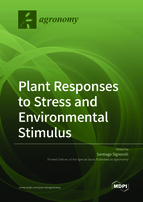Plant Responses to Stress and Environmental Stimulus
A special issue of Agronomy (ISSN 2073-4395). This special issue belongs to the section "Crop Breeding and Genetics".
Deadline for manuscript submissions: closed (15 May 2022) | Viewed by 38456
Special Issue Editor
2. Faculty of Science, ARC Centre for Plant Energy Biology, The University of Western Australia, Perth, Crawley, WA 6009, Australia
Interests: antioxidants; plant stress; ROS; RNS
Special Issue Information
Dear Colleagues,
Plants respond to diverse environmental stimuli such as light, nutrients, temperature, and oxygen, which shape their growth and fate. When these stimuli are suboptimal for adequate plant growth, they cause stress. This Special Issue aims to collect research articles providing evidence about plant responses to stresses and environmental stimuli. Methodological papers describing new technologies for plant phenotyping or evaluating plant responses and reviews providing a comprehensive view of this topic are welcome.
Dr. Santiago Signorelli
Guest Editor
Manuscript Submission Information
Manuscripts should be submitted online at www.mdpi.com by registering and logging in to this website. Once you are registered, click here to go to the submission form. Manuscripts can be submitted until the deadline. All submissions that pass pre-check are peer-reviewed. Accepted papers will be published continuously in the journal (as soon as accepted) and will be listed together on the special issue website. Research articles, review articles as well as short communications are invited. For planned papers, a title and short abstract (about 100 words) can be sent to the Editorial Office for announcement on this website.
Submitted manuscripts should not have been published previously, nor be under consideration for publication elsewhere (except conference proceedings papers). All manuscripts are thoroughly refereed through a single-blind peer-review process. A guide for authors and other relevant information for submission of manuscripts is available on the Instructions for Authors page. Agronomy is an international peer-reviewed open access monthly journal published by MDPI.
Please visit the Instructions for Authors page before submitting a manuscript. The Article Processing Charge (APC) for publication in this open access journal is 2600 CHF (Swiss Francs). Submitted papers should be well formatted and use good English. Authors may use MDPI's English editing service prior to publication or during author revisions.
Keywords
- abiotic stress
- biotic stress
- plant development
- plant signaling
- phytohormones






